
Last week, Microsoft announced that it’s made a major breakthrough in quantum computing. The company says its researchers have, for the first time, demonstrated the conditions needed to produce the elusive form of qubit that its quantum dreams are riding on: topological qubits.
The research was announced in Santa Barbara at Microsoft’s Station Q, where researchers have convened to discuss topological phases and quantum computing for the past 16 years. Microsoft said:
Building on two decades of scientific research and recent investments in simulation and fabrication, the Azure Quantum team has engineered devices that allow them to induce a topological phase of matter bookended by a pair of Majorana zero modes. These quantum excitations don’t normally exist in nature and must be coaxed into appearing under incredibly precise conditions.
Qubits..? —
They’re not the disgraced, short-lived streaming app Quibi nor the characteristic croaking of a frog, but a basic unit of quantum information. Microsoft just improved its ability to sustain these quantum bits.
Just as the “bit” is the fundamental unit of information in classical computing, the “qubit” is the fundamental unit of information in quantum computing. But here’s the difference: bits exist in a binary, “on” or “off,” 0 or 1. Qubits, however, can be much more complex for reasons that relate to the way that things can exist as both a particle and a wave. Computers have made sense of bits, but if we can make sense of the states of qubits, we can use them to send more complex information than just 0 or 1. Essentially, when you can put more data into a smaller package, you should be able to speed up computing.
In another post about the breakthrough, Microsoft explained:
[The quantum team] developed a process that layers semiconducting and superconducting materials onto a device in an extremely controlled and atomically precise way. In the presence of specific magnetic fields and voltages, the devices can produce a topological phase with a pair of Majorana zero modes — characterized by telltale energy signatures that will appear at either end of a nanowire under the right conditions — and a measurable topological gap.
What’s next? —
While quantum computing is still in its early days, it’s already outpaced classical computing on certain algorithms such as the Shors algorithm that finds the prime factors of an integer. This matters because modern cryptography (which is used to make your online banking secure, for example) relies on the idea that factoring large numbers is very, very difficult. In general, the exact use cases for quantum computers aren’t well known.
The path toward advanced quantum computing is long, but this recent breakthrough allows researchers to better send and receive information via the complex, superimposed values in qubits.
“We have discovered that we can produce the topological superconducting phase and its concomitant Majorana zero modes, clearing a significant hurdle toward building a scaled quantum machine,” said Microsoft’s Dr. Chetan Nayak. “This proves the key aspects of this elusive physics and now it’s full steam ahead to the topological qubit,” he added, in a press release.
“There’s no fundamental obstacle to producing a topological qubit anymore,” said Microsoft engineer Lauri Sainiemi.







